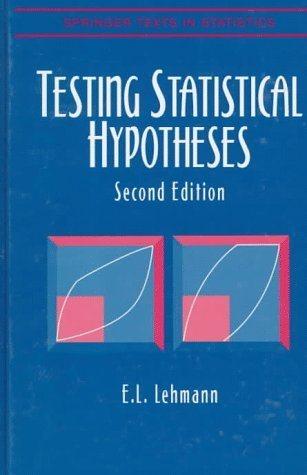21. Continuation . For testing the hypothesis of independence of the X's, H : Po = PI'...
Question:
21. Continuation . For testing the hypothesis of independence of the X's, H : Po = PI' against the alternatives K : Po < PI' consider the run test, which rejects H when the total number of runs R = U + V is less than a constant C( m) depending on the number m of zeros in the sequence. When R = C( m), the hypothesis is rejected with probability y( m), where C and y are determined by PH{R < C(m)lm} + y(m)PH{R = C(m)lm} =
a. (i) Against any alternative of K the most powerful similar test (which is at least as powerful as the most powerful unbiased test) coincides with the run test in that it rejects H when R < C( m). Only the supplementary rule for bringing the conditional probability of rejection (given m) up to a depends on the specific alternative under consideration. (ii) The run test is unbiased against the alternatives K. (iii) The conditional distribution of R given m, when H is true, is" 2( m- 1)(n - 1) ,-1 ,-1 (m;:; n) P{R=2,}=- P{ R = 2, + I} = (~~ll)(n-;l) +(m~l)(;=i) (m;:;n) [(i): Unbiasedness implies that the conditional probability of rejection given m is a for all m. The most powerful conditional level-a test rejects H for those sample sequences for which l1(u, v) = (Po/PI)"(ql/qo)U is too large. Since Po < PI and ql < qo and since Iv - ul can only take on the values 0 and 1, it follows that 11(1,1) > l1(1,2), l1(2,1) > l1(2,2) > l1(2,3), l1(3,2) > . . . Thus only the relation between l1(i, i + 1) and l1(i + 1, i) depends on the specific alternative, and this establishes the desired result. (ii): That the above conditional test is unbiased for each m is seen by writing its power as ,8(Po,pdm) = (1 - y)P{R < C(m)lm} + yP{R:5 C(m)lm}, ·This distribution is tabled by Swed and Eisenhart (1943) and can be obtained from the hypergeometric distribution [Guenther (1978)). For further discussion of the run test, see Wolfowitz (1943).
since by (i) the rejection regions R < C( m) and R < C( m) + 1 are both UMP at their respective conditional levels. (iii): When H is true, the conditional probability given m of any set of m zeros and n ones is 1/( m n). The number of ways of dividing n ones into, groups is (~ =: ~), and that of dividing m zeros into, + 1 groups is ( m 1) . The conditional probability of getting, + 1 runs of zeros and r runs of ones is therefore (m~I)(;=n (m;:;n) To complete the proof, note that the total number of runs is 2, + 1 if and only if there are either, + 1 runs of zeros and r runs of ones or r runs of zeros and r + 1 runs of ones.]
Step by Step Answer:







